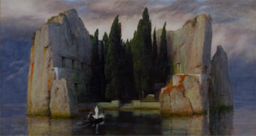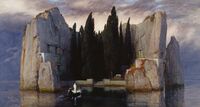Mysterious painting
From Nookipedia, the Animal Crossing wiki
Revision as of 10:39, May 14, 2022 by Cephalobot (talk | contribs) (Text replacement - "|artist= " to "|artist = ")
| ||||||
 The Mysterious Painting in Animal Crossing: New Horizons | ||||||
| Real-world counterpart | ||||||
|---|---|---|---|---|---|---|
| Isle of the Dead | ||||||
| Year | 1883 | |||||
| Artist | Arnold Böcklin | |||||
| Main appearances | ||||||
|
| ||||||
Name in other languages
なぞめいためいが
神秘的名画 Toile ténébreuse Cuadro tenebroso Quadro misterioso Загадочная картина
미스터리한 명화 神秘的名畫 Toile ténébreuse Cuadro tenebroso Rätselgemälde Mysterieus schilderij | ||||||
The Mysterious Painting is a painting in Animal Crossing: New Horizons introduced in the 1.2.0 April Free Update. It is based on Arnold Böcklin's Isle of the Dead.
Art details
In New Horizons
| Museum description | A small boat carrying a corpse glides quietly over a still sea to an island of graves surrounded by cliffs. The air of this piece by symbolist painter Böcklin is chilling, but also somehow calm. Böcklin worked here to capture not what he could see, but some of humanity's inner contemplations. |
|---|---|
| Buy price | |
| Sell price | |
| Obtain from | |
| Authenticity | This painting is always genuine. |
| Furniture size |
Real-world information
Isle of the Dead was produced in several different versions. The version that is used in Animal Crossing: New Horizons is the third one, which was painted in 1883 and is now exhibited in the Berlin State Museum.
This image is an illustration of a scene or object from a video game.
The copyright for it is most likely owned by either the publisher/producer and/or artist(s) producing the work in question. It is believed that the use of web-resolution images of artwork for commentary on the scene or object in question qualifies as fair use under United States copyright law. See Wikipedia:Fair use for more information.
This image is an illustration of a scene or object from a video game.
The copyright for it is most likely owned by either the publisher/producer and/or artist(s) producing the work in question. It is believed that the use of web-resolution images of artwork for commentary on the scene or object in question qualifies as fair use under United States copyright law. See Wikipedia:Fair use for more information.
